Barker (1651) makes the rod ’of a hasel of one piece, or of two pieces set together in the most convenient manner, light and gentle.’ He recommends the use of a single hair next the fly,—’you shall have more rises,’ which is true, ‘and kill more fish,’ which is not so likely. The most delicate striking is required with fine gut, and with a single hair there must be many breakages. For salmon, Barker uses a rod ten feet in the butt, ‘that will carry a top of six foot pretty stiffe and strong.’ The ‘winder,’ or reel, Barker illustrates with a totally unintelligible design. His salmon fly ‘carries six wings’; perhaps he only means wings composed of six kinds of feathers, but here Franck is a better authority, his flies being sensible and sober in colour. Not many old salmon flies are in existence, nor have I seen more ancient specimens than a few, chiefly of peacocks’ feathers, in the fly-leaf of a book at Abbotsford; they were used in Ireland by Sir Walter Scott’s eldest son. The controversy as to whether fish can distinguish colours was unknown to our ancestors. I am inclined to believe that, for salmon, size, and perhaps shade, light or dark, with more or less of tinsel, are the only important points. Izaak stumbled on the idea of Mr. Stewart (author of The Practical Angler) saying, ’for the generality, three or four flies, neat, and rightly made, and not too big, serve for a trout in most rivers, all the summer.’ Our ancestors, though they did not fish with the dry fly, were intent on imitating the insect on the water. As far as my own experience goes, if trout are feeding on duns, one dun will take them as well as another, if it be properly presented. But my friend Mr. Charles Longman tells me that, after failing with two trout, he examined the fly on the water, an olive dun, and found in his book a fly which exactly matched the natural insect in colour. With this he captured his brace.
Such incidents look as if trout were particular to a shade, but we can never be certain that the angler did not make an especially artful and delicate cast when he succeeded. Sir Herbert Maxwell intends to make the experiment of using duns of impossible and unnatural colours; if he succeeds with these, on several occasions, as well as with orthodox flies, perhaps we may decide that trout do not distinguish hues. On a Sutherland loch, an angler found that trout would take flies of any colour, except that of a light-green leaf of a tree. This rejection decidedly looked as if even Sutherland loch trout exercised some discrimination. Often, on a loch, out of three flies they will favour one, and that, perhaps, not the trail fly. The best rule is: when you find a favourite fly on a salmon river, use it: its special favouritism may be a superstition, but, at all events, salmon do take it. We cannot afford to be always making experiments, but Mr. Herbert Spencer, busking his flies the reverse way, used certainly to be at least as successful with sea trout as his less speculative neighbours in Argyllshire.




